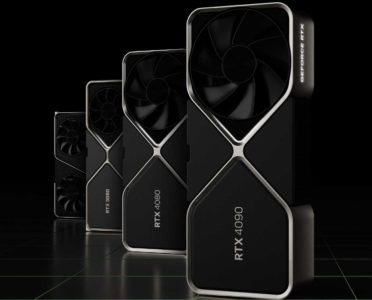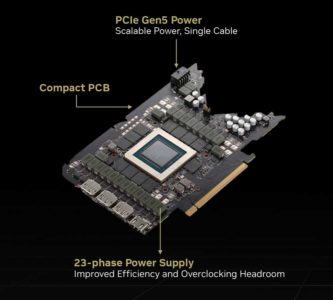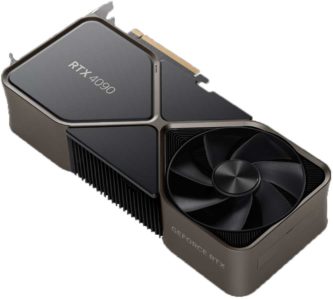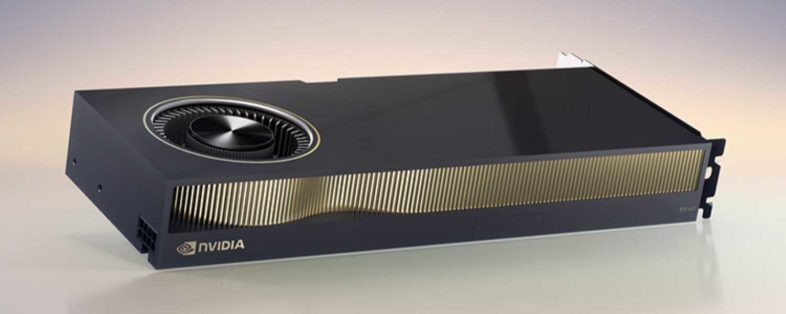NVidia announced their next generation of GPU architecture, named after Ada Lovelace, who is an interesting figure in early computer programming. NVidia’s newest Ada Lovelace chips have up to 18,432 CUDA cores, and up to 76 Billion transistors, at 4nm sizes. This will of course lead to increased processing performance at lower prices and power usage.
 The new changes in the software SDK and rendering level are DLSS 3.0 for super sampling, RTX Remix, for adding new rendering features to mods on older games, and shader execution reordering for improved performance, displaced micro-meshes for finer shadow detail, opacity micro maps for cleaner ray tracing, and NVidia Reflex for coordinating the CPU with the GPU. The biggest render function unique to the new generation is optical flow acceleration which is AI generated frames for higher frame rates. Ada Lovelace chips have the addition of Optical Flow Accelerators in the hardware, and NVidia is training the AI models for this technology on their own supercomputers. Ray-Tracing is now far more efficient with the newer generation RT cores. RTX Racer will be a tech demo application released later this year for free, which will leverage all of these new technologies. RTX Remix has the ability to extract 3D objects right from the GPU draw cards, and create USD assets from them. It also adds ray tracing to older games by intercepting draw calls from DirectX. User can further customize any RTX mod in real-time by adjusting various render settings. As someone who usually plays older games, this is exciting as I suspect it will lead to all sorts of improvements to older titles.
The new changes in the software SDK and rendering level are DLSS 3.0 for super sampling, RTX Remix, for adding new rendering features to mods on older games, and shader execution reordering for improved performance, displaced micro-meshes for finer shadow detail, opacity micro maps for cleaner ray tracing, and NVidia Reflex for coordinating the CPU with the GPU. The biggest render function unique to the new generation is optical flow acceleration which is AI generated frames for higher frame rates. Ada Lovelace chips have the addition of Optical Flow Accelerators in the hardware, and NVidia is training the AI models for this technology on their own supercomputers. Ray-Tracing is now far more efficient with the newer generation RT cores. RTX Racer will be a tech demo application released later this year for free, which will leverage all of these new technologies. RTX Remix has the ability to extract 3D objects right from the GPU draw cards, and create USD assets from them. It also adds ray tracing to older games by intercepting draw calls from DirectX. User can further customize any RTX mod in real-time by adjusting various render settings. As someone who usually plays older games, this is exciting as I suspect it will lead to all sorts of improvements to older titles.
 New GeForce Cards
New GeForce Cards
The main new products that are headlining this announcement are new GeForce 4090 and 4080 cards, which should far outclass the previous generation released two years ago. They also, contrary to numerous rumors, should consume less energy than the existing power hungry Ampere cards. The 4090 with have 24GB of memory, similar to the previous generation, while the 4080 will come in 12GB and 16GB variants, with the 16GB version also being a more powerful chip, not just having more RAM. Even the lower class of 4080 outperforms the existing 3090 Ti in most cases.
 All of the new cards will have a PCIe Gen5 power connector, which offers up to 600W of power, but all the cards draw much less energy than that. They do not have PCIe Gen5 slot connectors, but that is because they have yet to saturate the bandwidth available in a PCIe Gen4 slot.
All of the new cards will have a PCIe Gen5 power connector, which offers up to 600W of power, but all the cards draw much less energy than that. They do not have PCIe Gen5 slot connectors, but that is because they have yet to saturate the bandwidth available in a PCIe Gen4 slot.
AV1 Encoding
One of the other significant new features in this generation of chips is the addition of hardware acceleration for AV1 encoding. AV1 decoding support was already included in the existing Ampere chips, but this is the first hardware encoder available outside of Intel’s hard to find discrete graphics cards. AV1 is a video codec that claims to offer 30% more efficient compression than HEVC, while being open source and royalty-free. Netflix and a few other large tech companies have been offering AV1 as a streaming option for a while now, but it has not been much of an option for smaller content creators.  That is about to change with new software coming, like a hardware accelerated AV1 encoding plug-in for Premiere Pro and DaVinci Resolve, as well as integrated AV1 streaming support coming in OBS and Discord that will use the new hardware acceleration. DaVinci Resolve now utilizes GPU for RAW decode, AI analysis, and encoding, making it a real GPU computing powerhouse. I imagine that YouTube will soon have a lot of AV1 content streaming through it in the near future. The new cards have dual encoders, which work in parallel by dividing each frame between them, allowing up to 8Kp60 encoding in real time. I assume lower end cards in the future will have a single encoder for 8Kp30, which should be good enough for most people.
That is about to change with new software coming, like a hardware accelerated AV1 encoding plug-in for Premiere Pro and DaVinci Resolve, as well as integrated AV1 streaming support coming in OBS and Discord that will use the new hardware acceleration. DaVinci Resolve now utilizes GPU for RAW decode, AI analysis, and encoding, making it a real GPU computing powerhouse. I imagine that YouTube will soon have a lot of AV1 content streaming through it in the near future. The new cards have dual encoders, which work in parallel by dividing each frame between them, allowing up to 8Kp60 encoding in real time. I assume lower end cards in the future will have a single encoder for 8Kp30, which should be good enough for most people.
 Professional RTX
Professional RTX
There is a new RTX 6000 professional GPU coming in December, not to be confused with the identically named Turing based card two generations ago. NVidia’s pro-viz naming product naming has really gone downhill since they dropped the Quadro branding. But regardless of what it is called, the new RTX 6000 should be a very powerful graphics card, with NVidia claiming up to twice the performance of the current A6000. It has a similar underlying Ada Lovelace chip to the 4090, but with a lower 300W power envelope, and a more manageable size with a two slot cooling solution.
So there is a whole new generation of hardware coming, and it will get here soon. Both Intel and AMD are releasing their next generation of CPUs, and we will have new graphics cards to go with them. And even if you can’t afford a new high end Ada Lovelace GPU, hopefully this will drive down the prices for the previous generation cards that have been so difficult to find up to this point, due to the crypto-currency craze. One way or another, faster GPUs are coming, and I am looking forward to all that they bring to the table.


